lexus LFA 2012 Owner's Manual / LEXUS 2012 LFA OWNERS MANUAL (OM77006U)
Manufacturer: LEXUS, Model Year: 2012, Model line: LFA, Model: Lexus LFA 2012Pages: 420, PDF Size: 5.02 MB
Page 341 of 420
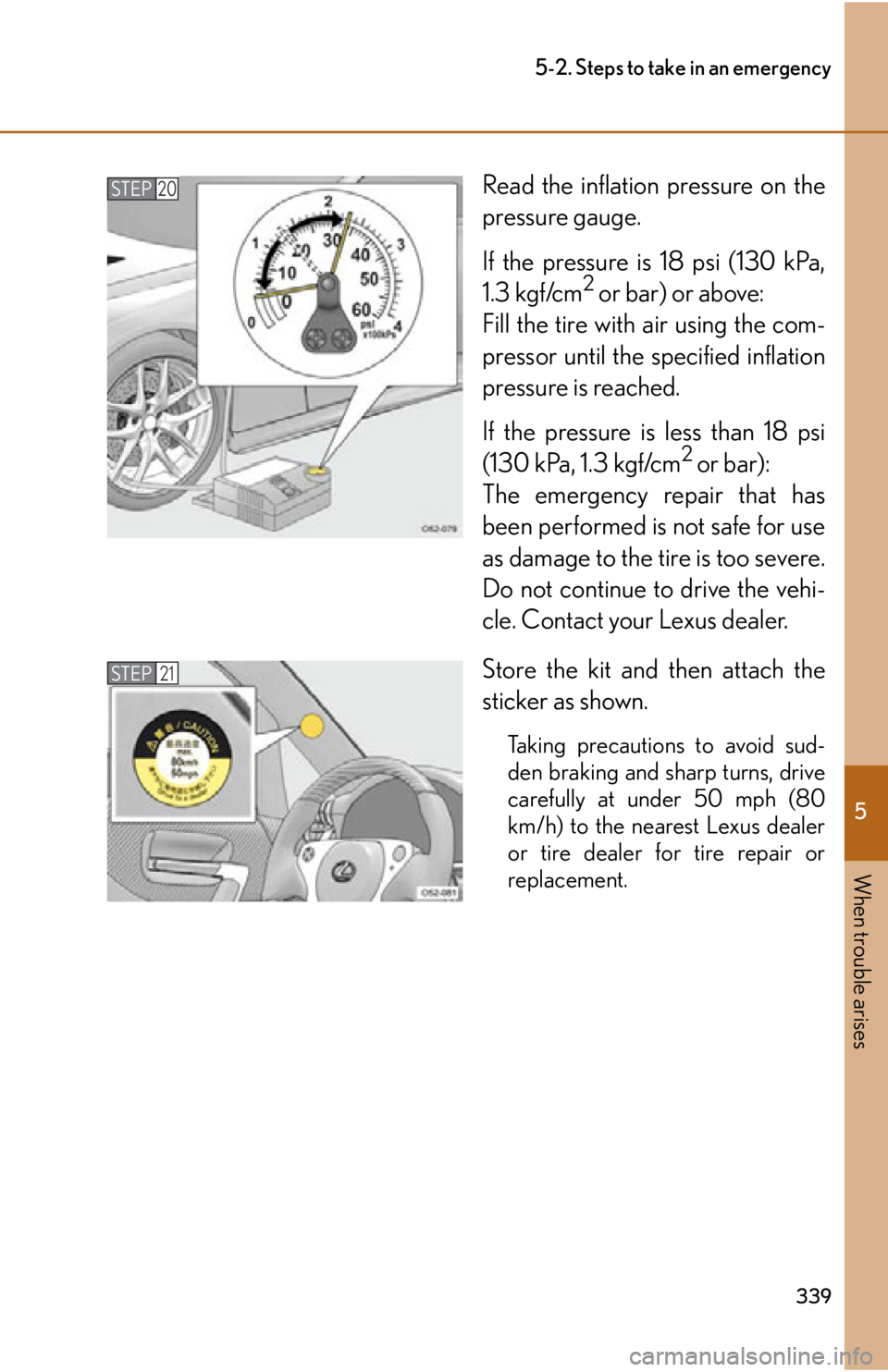
5
When trouble arises
339
5-2. Steps to take in an emergency
Read the inflation pressure on the
pressure gauge.
If the pressure is 18 psi (130 kPa,
1.3 kgf/cm
2 or bar) or above:
Fill the tire with air using the com-
pressor until the specified inflation
pressure is reached.
If the pressure is less than 18 psi
(130 kPa, 1.3 kgf/cm
2 or bar):
The emergency repair that has
been performed is not safe for use
as damage to the ti re is too severe.
Do not continue to drive the vehi-
cle. Contact your Lexus dealer.
Store the kit and then attach the
sticker as shown.
Taking precautions to avoid sud-
den braking and sharp turns, drive
carefully at under 50 mph (80
km/h) to the nearest Lexus dealer
or tire dealer for tire repair or
replacement.
STEP 20
STEP21
Page 342 of 420

340
5-2. Steps to take in an emergency
■Sealant
●One tire can be repaired using the bottle of sealant stored in the emergency tire
puncture repair kit.
●The sealant can be used when the outside temperature is from -22°F (-30°C)
to 140°F (60°C).
●When the outside temperature is low, the viscosity of the sealant becomes high
and it will be more difficult to inject th e sealant. In this case, warm the sealant in
the vehicle before using it.
●The sealant has a limited lifespan. The expi ration date is marked on the bottle.
The sealant should be replaced before the expiration date. Contact your Lexus
dealer.
●If the sealant gets on your clothes, it may stain.
●After using the sealant, bring the empty bottle of sealant to your Lexus dealer
and purchase a new bottle. Keep the ne w bottle of sealant in your vehicle.
■Compressor
●The compressor is a pneumatic filling type for passenger vehicles.
●When the compressor is operating, a loud operating noise will be produced.
This does not indicate a malfunction.
■The wheel of a tire that has been repaired
If you remove the sealant adhering to the wheel with a rag, you can reuse the wheel.
■The valve of a tire that has been repaired
●After a tire is repaired with the emergency tire puncture repair kit, the tire pres-
sure warning valve and transm itter should be replaced.
●After a tire is repaired with the emergency tire puncture repair kit, even if the
tire inflation pressure is at the recommended level, the tire pressure warning
light may come on/flash.
Page 343 of 420

5
When trouble arises
341
5-2. Steps to take in an emergency
CAUTION
■Precaution for children
Keep the emergency tire puncture repair kit out of the reach of children and store it
properly.
■Sealant precautions
●The sealant in the emergency tire puncture repair kit is not for human consump-
tion.
If the sealant is consumed, drink a large quantity of water and get medical atten-
tion immediately.
●If sealant gets in your eyes or on your skin, thoroughly wash with a large quantity
of water. If necessary, get medical attention.
■When fixing the flat tire
●Stop your vehicle in a safe and flat area.
●If force is used to turn the valve core tool while air remains in the tire, special care
should be taken because the valve core could fly out.
●Be careful, as sealant may fly out if you shake the bottle with the hose installed.
●If the hose is not securely installed, sealant may leak out when filling.
●Connect the valve and hose securely with the tire installed on the vehicle.
●Be careful handling the compressor, as parts of the compressor get hot during
operation. Some parts of the compressor may remain hot after use.
●Do not attach the vehicle speed warning sticker to an area other than the one
indicated. If the sticker is attached to an area where an SRS airbag is located,
such as the pad of the steering wheel, it may prevent the SRS airbag from operat-
ing properly.
■Driving to spread the liquid sealant evenly
Drive cautiously at a moderate speed, avoi ding sudden starts, sudden braking, and
abrupt steering maneuvers.
Page 344 of 420

342
5-2. Steps to take in an emergency
NOTICE
■Vehicles with a flat tire
Do not continue driving with a flat tire.
Driving even a short distance with a flat tire can damage the tire and the wheel
beyond repair.
■When performing an emergency repair
Perform the emergency repair without removing the nail or screw that has punc-
tured the tread of the tire. If the object th at has punctured the tire is removed, the
repair using the sealant in the emergenc y tire puncture repair kit may fail.
■When fixing the flat tire
●Do not put the valve core on dirty ground or in the sand.
Store it in a clean place.
●Do not remove the inside cap of the sealant bottle.
●Turn the valve core tool with your hand when screwing it in. If you use another tool
in conjunction with the valve core tool, damage may occur.
●Do not operate the compressor continuously for more than 10 minutes. The
motor may overheat and be damaged. Le t the compressor cool before using it
again.
■Compressor precautions
●The compressor power source should be 12 V DC suitable for vehicle use.
Do not connect the compressor to 24 V DC or any other power source.
●The compressor is an oil-less type. Do not lubricate with oil.
●If the compressor does not operate properly or becomes hot, it may be over-
heated. Turn off the switch and leave the compressor to cool down for at least 30
minutes.
●The compressor is not waterproof. Make sure that the compressor is not exposed
to water, such as when it is being used in the rain.
●Do not put the compressor directly onto dusty ground such as sand at the side of
the road. If the compressor vacuums up dust etc., a malfunction may occur.
●Do not disassemble or modify the compre ssor. Do not subject parts such as the
air pressure indicator to impacts. This may cause a malfunction.
Page 345 of 420

5
When trouble arises
343
5-2. Steps to take in an emergency
If the engine will not start
If the engine will not start, even though correct starting procedures are being
followed (
P. 98), consider each of the following points.
■ The engine will not start even when the starter motor operates nor-
mally.
One of the following may be the cause of the problem.
● There may not be sufficient fuel in the vehicle’s tank.
Refuel the vehicle.
● The engine may be flooded.
Try to restart the engine once more following correct starting pro-
cedures. ( P. 9 8 )
● There may be a malfunction in the engine immobilizer system.
( P. 5 3 )
■ The starter motor turns over slowly , the interior lights and headlights
are dim, or the horn does not sound or sounds at a low volume.
One of the following may be the cause of the problem.
● The battery may be discharged. ( P. 3 4 8 )
● The battery terminal connections may be loose or corroded.
■ The starter motor does not turn over, the interior lights and head-
lights do not turn on, or the horn does not sound.
One of the following may be the cause of the problem.
● One or both of the battery terminals may be disconnected.
● The battery may be discharged. ( P. 3 4 8 )
Contact your Lexus dealer if the prob lem cannot be repaired, or if repair
procedures are unknown.
Page 346 of 420

344
5-2. Steps to take in an emergency
If you lose your keys/wireless remote control transmitter
■Keys
New genuine Lexus keys can be made by your Lexus dealer using the
other keys and the key number stamped on your key number plate.
However, there may be cases where an additional premium master key
cannot be made. For details, ask your Lexus dealer.
■ Wireless remote control transmitter
New genuine wireless remote control transmitters can be purchased
and programmed by your Lexus deal er. If a wireless remote control
transmitter has been lost, bring th e other wireless remote control
transmitter when going to pick up the new transmitter.
Page 347 of 420
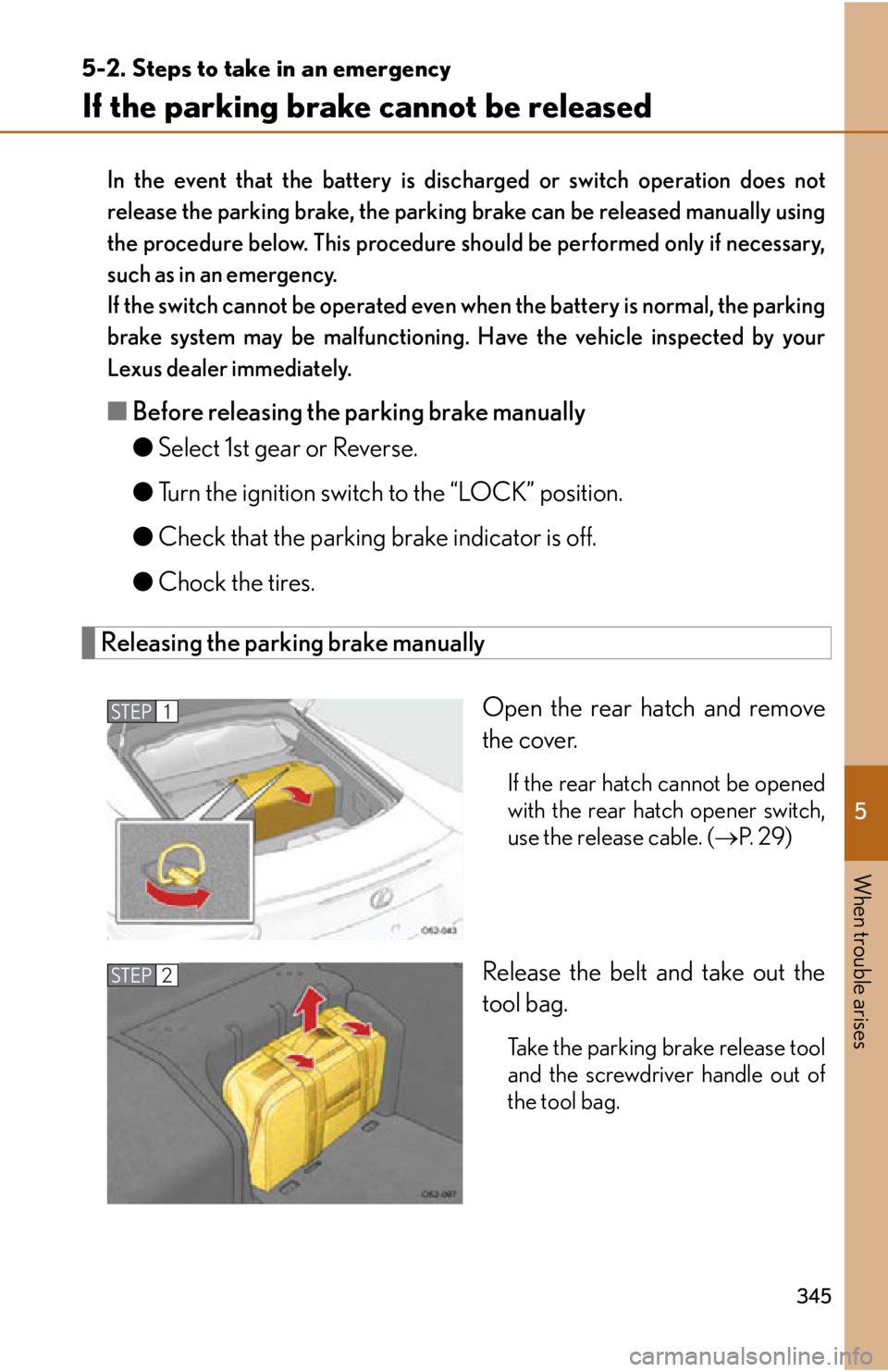
5
When trouble arises
345
5-2. Steps to take in an emergency
If the parking brake cannot be released
In the event that the battery is discharged or switch operation does not
release the parking brake, the parking brake can be released manually using
the procedure below. This procedure should be performed only if necessary,
such as in an emergency.
If the switch cannot be operated even when the battery is normal, the parking
brake system may be malfunctioning. Have the vehicle inspected by your
Lexus dealer immediately.
■ Before releasing the parking brake manually
●Select 1st gear or Reverse.
● Turn the ignition switch to the “LOCK” position.
● Check that the parking brake indicator is off.
● Chock the tires.
Releasing the parking brake manually
Open the rear hatch and remove
the cover.
If the rear hatch cannot be opened
with the rear hatch opener switch,
use the release cable. (P. 2 9 )
Release the belt and take out the
tool bag.
Take the parking brake release tool
and the screwdriver handle out of
the tool bag.
STEP1
STEP2
Page 348 of 420
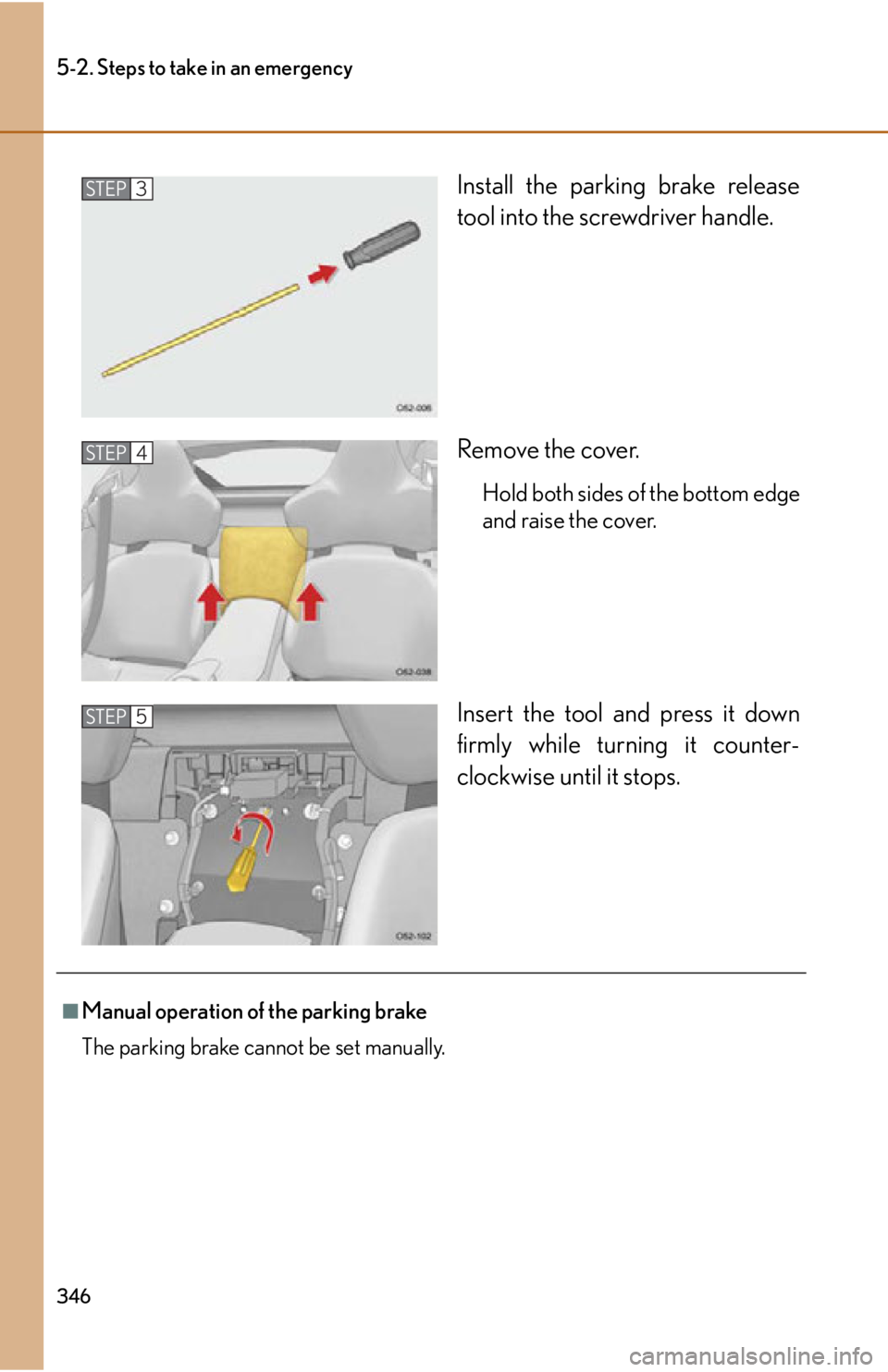
346
5-2. Steps to take in an emergency
Install the parking brake release
tool into the screwdriver handle.
Remove the cover.
Hold both sides of the bottom edge
and raise the cover.
Insert the tool and press it down
firmly while turning it counter-
clockwise until it stops.
STEP3
STEP4
STEP5
■Manual operation of the parking brake
The parking brake cannot be set manually.
Page 349 of 420
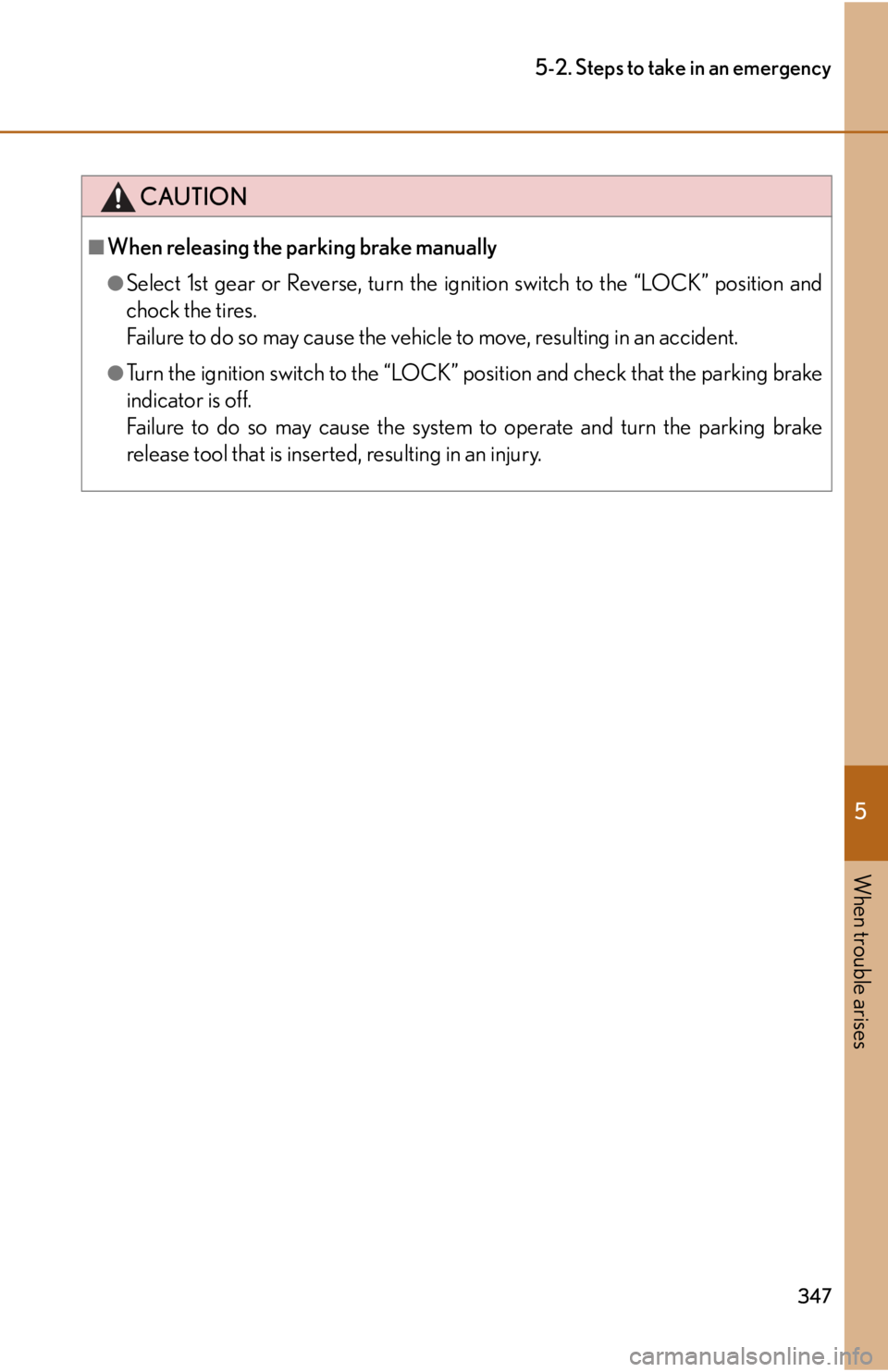
5
When trouble arises
347
5-2. Steps to take in an emergency
CAUTION
■When releasing the parking brake manually
●Select 1st gear or Reverse, turn the ignition switch to the “LOCK” position and
chock the tires.
Failure to do so may cause the vehicle to move, resulting in an accident.
●Turn the ignition switch to the “LOCK” position and check that the parking brake
indicator is off.
Failure to do so may cause the system to operate and turn the parking brake
release tool that is inserted, resulting in an injury.
Page 350 of 420
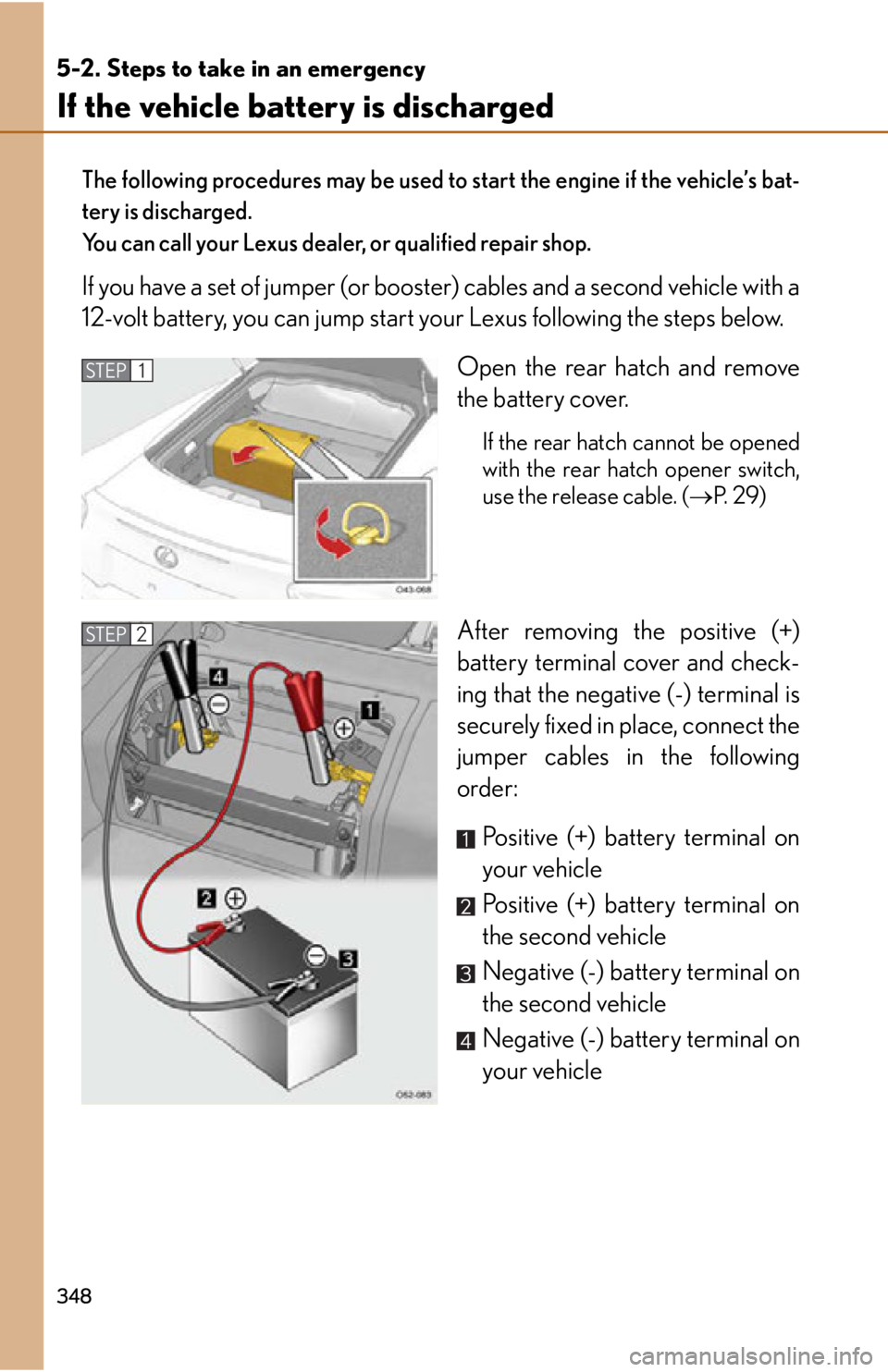
348
5-2. Steps to take in an emergency
If the vehicle battery is discharged
The following procedures may be used to start the engine if the vehicle’s bat-
tery is discharged.
You can call your Lexus dealer, or qualified repair shop.
If you have a set of ju mper (or booster) cables and a second vehicle with a
12-volt battery, you can jump start yo ur Lexus following the steps below.
Open the rear hatch and remove
the battery cover.
If the rear hatch cannot be opened
with the rear hatch opener switch,
use the release cable. ( P. 2 9 )
After removing the positive (+)
battery terminal cover and check-
ing that the negative (-) terminal is
securely fixed in place, connect the
jumper cables in the following
order:
Positive (+) battery terminal on
your vehicle
Positive (+) battery terminal on
the second vehicle
Negative (-) battery terminal on
the second vehicle
Negative (-) battery terminal on
your vehicle
STEP1
STEP2